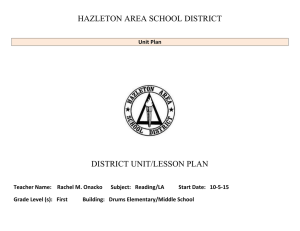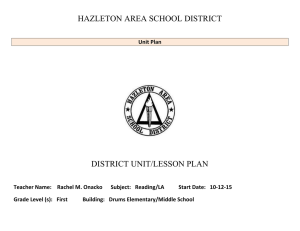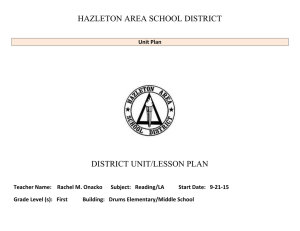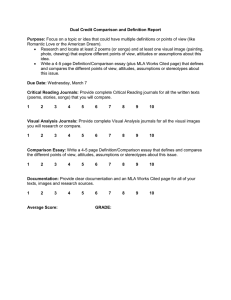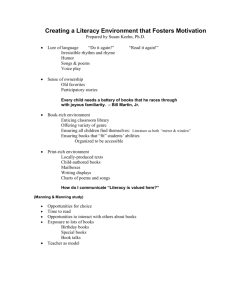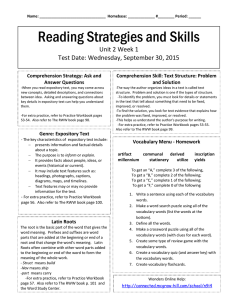HAZLETON AREA SCHOOL DISTRICT DISTRICT UNIT/LESSON PLAN
advertisement
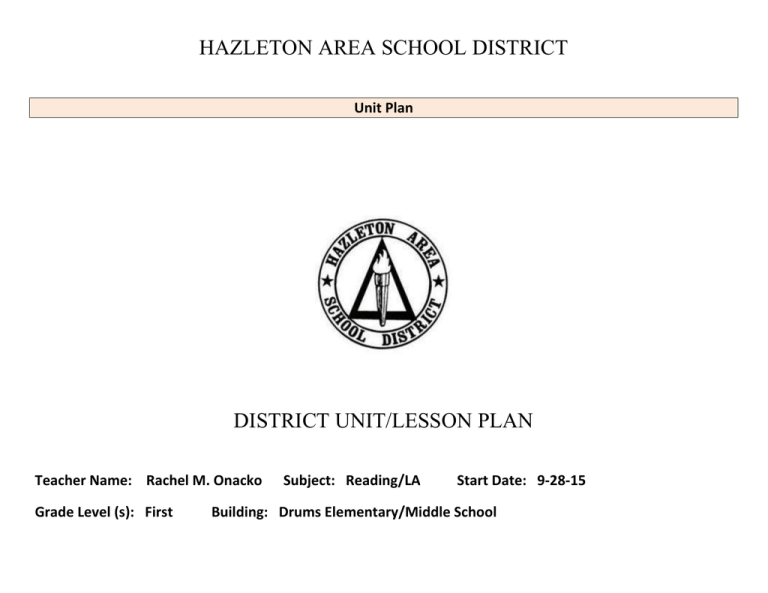
HAZLETON AREA SCHOOL DISTRICT Unit Plan DISTRICT UNIT/LESSON PLAN Teacher Name: Rachel M. Onacko Grade Level (s): First Subject: Reading/LA Start Date: 9-28-15 Building: Drums Elementary/Middle School Unit Title: Theme 1: Exploring Differences in Each Other and Our Community Essential Questions: What makes you special? What do you do at your school? What is it like where you live? What makes a pet special? What do friends do together? How does your body move? How does your community affect you? How can you become involved in your community? How does our culture and background affect your community? Are we more different or alike? Standards: PA Core Standards, PA Academic Standards/Anchors (based on subject) CC.1.1.1.B Demonstrate understanding of the organization and basic features of text CC.1.1.1.C Demonstrate understanding of spoken words, syllables, and sounds/phonemes CC.1.1.1.D Know and apply grade level phonics and word analysis skills and decoding of words CC.1.2.1.A Identify the main idea and retell key details of text CC.1.2.1.B Ask and answer questions about key details in a text CC.1.2.1.E Use various text features to locate key details of text CC.1.2.1.G Use illustrations and details in a text to describe its key ideas CC.1.2.1.J Use words and phrases acquired through conversations, reading, and being read to, as well as responding to texts, including words that signal connections and relationships between the words and phrases CC.1.3.1.A Retell stories including key details and demonstrate understanding of their central message/lesson CC.1.3.1.B Ask and answer questions about key details in a text CC.1.3.1.C Describe characters, setting, and major events in a story using key details CC.1.3.1.G Use illustrations and details in a story to describe characters, setting, or events CC.1.3.1.H Determine or clarify the meaning of unknown or multiple meaning words or phrases based on grade level reading or content CC.1.4.1.R Demonstrate a grade appropriate command of the conventions of standard English grammar, usage, capitalization, punctuation, and spelling CC.1.4.1.X Write routinely for a range of discipline specific tasks, purposes, and audiences CC.1.5.1.A Participate in collaborative conversations with peers and adults in small and large groups CC.1.5.1.B Confirm understanding of a text read aloud or information presented orally or through other media by asking and answering questions about key details and requesting clarification if not understood CC.1.5.1.C Ask and answer questions about what a speaker says in order to gather additional information or clarify something that is not understood CC.1.5.1.D Describe people, places, things, and events with relevant details, expressing ideas and feelings clearly CC.1.5.1.E Produce complete sentences appropriate to task and situation CC.1.5.1.G Demonstrate command of the conventions of standard English when speaking based on Grade 1 level and content Summative Unit Assessment : Summative Assessment Objective Students will begin to understand that the world doesn’t consist of only me. Students will start thinking of others and how they can interact in the community. Assessment Method (check one) ____ Rubric ___ Checklist ____ Skills Test __X__ Group __X__ Student Self-Assessment ____ Other (explain) DAILY PLAN 1 DOK Activities / Teaching LEVEL Strategies Students will 1 daily Morning Message ...demonstrate 2 concepts of print understanding of oral language concepts of print. chart poems/songs …orally produce phonemic segmentation/ single syllable blending words by blending phonics consonant blends sounds. making words activity …isolate and high frequency words pronounce initial, journal writing medial vowel, and listening comprehension final sounds in guided reading CVC words. …decode regularly spelled one syllable words. …recognize and read grade appropriate Objective (s) Materials / Resources Morning Message Chart poems/songs Teacher Manual RWW Big Book Literature Big Book Cool Dog, School Dog RWW Student Book “A Pig for Cliff” Practice Workbook Online Resources Poster High Frequency Cards Sound Spelling Cards Word Building Cards Photo Cards Grou ping Day S W I Assessment of Objective (s) FormativeTeacher observation; class participation Summativecompleted workbook pages 21, 22; journal writing Student Self AssessmentSelf check papers 2 irregularly spelled words. …use conventional spelling for words with common spelling patterns. …use end punctuation. …produce and expand complete sentences in response to prompts. Students will… 1 ….ask questions to 2 clear any confusion about topics and texts under discussion. …recognize the distinguishing features of a sentence. …demonstrate understanding of concepts of print. …orally produce Writing Journals Leveled/Decodable Readers daily Morning Message concepts of print oral language chart poems/songs phoneme segmentation/blending phonics consonant blends high frequency words journal writing listening comprehension guided reading pair partner reading graphic organizer S W i Morning Message Chart poems/songs RWW Big Book RWW Student Book “A Pig for Cliff” Practice Workbook Online Resources Teaching Poster High Frequency Cards Sound Spelling Cards Word Building Cards Formative-class participation; teacher observation SummativeCompleted workbook pages 21, 22; journal writing Student Self Assessmentpartner check single syllable words by blending sounds including consonant blends. …decode regularly spelled onesyllable words. …to read words with inflectional endings. …isolate and pronounce initial, medial vowel, and final sounds in words. …recognize and read grade appropriate irregularly spelled words. …ask and answer questions about key details in text. …focus on a topic, respond to questions, and add details to Photo Cards Writing Journals Leveled/Decodable Readers papers writing. …produce and expand complete sentences in response to prompts. 3 Students will 1 …demonstrate 2 concepts of print. …retell stories, including key details and demonstrate understanding of their central message or lesson. …isolate and pronounce initial, medial, and final phonemes in single syllable words. …decode regularly spelled one syllable words. daily Morning Message concepts of print oral language chart poems/songs phoneme segmentation/blending phonics consonant blends high frequency words listening comprehension writing journals guided reading graphic organizer S W I Morning Message chart poems/songs RWW Student Book Literature Anthology Flip Practice Workbook Online Resources Teaching Poster/Graphic Organizer High Frequency Cards Sound Spelling Cards Word Building Cards Photo Cards Writing Journals Leveled/Decodable Readers Formative-thumbs up thumbs down, teacher observation, class participation Summativecompleted workbook pages 23, 24; graphic organizer Student Self AssessmentSelf check papers 4 …read words with inflectional endings. …recognize and read grade appropriate irregularly spelled words. …read grade level text orally with accuracy, appropriate rate, and expression. …ask and answer questions about key details Students will 1 …demonstrate an 2 understanding of concepts of print. …know and use text features to locate key facts or information in a text. …use the illustrations and daily Morning Message concepts of print oral language chart poems/songs phoneme segmentation/blending phonics consonant blends high frequency words listening comprehension writing journals guided reading S W I Morning Message chart poems/songs Literature Anthology Tear and Take story “Kim and Flick” Practice Workbook Online resources Teaching Poster High Frequency Cards Formativeteacher observation, class participation Summativecompleted workbook pages 27, 30 Student Self - details in a text to describe key ideas. …-decode regularly spelled one syllable words. …read words with inflectional endings. …recognize and read grade appropriate irregularly spelled words …focus on a topic, respond to questions and add details to writing. …produce and expand complete sentences in response to prompts. …know and use various text features to locate pair partner reading graphic organizer Sound Spelling Cards Word Building Cards Photo Cards Writing Journals Leveled/Decodable Readers Reader Response Journals Assessmentpartner check papers 5 key facts or information in a text. Students will 1 …demonstrate an 2 understanding of concepts of print. …segment spoken single syllable words into their complete sequence of individual sounds. …decode regularly spelled one syllable words. …read words with inflectional endings. …use end punctuation for sentences. …ask and answer questions about key details. …focus on a topic, respond to Daily Morning Message concepts of print oral language chart poems/songs phoneme segmentation/blending phonics consonant blends high frequency words listening comprehension writing journals guided reading pair partner reading graphic organizer S W I Morning Message chart poems/songs RWW Student Book Literature Anthology Literature Nonfiction selection “What Pets Need” Practice Workbook Online resources Poster High frequency cards Sound spelling cards Word building cards Photo cards Writing Journals Leveled/Decodable Readers Reader Response Journals Formative-teacher observation, class participation Summative- end of week skills check, consonant blend spelling test, short vowel a/i quiz; workbook pages 27, 29, 30; graphic organizer Student Self AssessmentCompleted WB pages, graphic organizer questions, and add details to writing, …produce and expand complete sentences in response to prompts. Students will- FormativeSummative- 6 Student Self Assessment-
